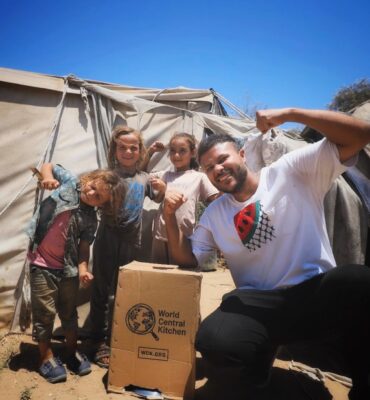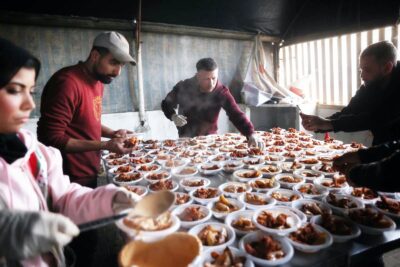
Hamada Shaqoura’s unflinching stare over the wood fire as he stirs food in large pots has gained people’s attention worldwide. The once carefree and indulgent food blogger now cooks with a purpose for the children in Gaza. Making use of whatever little food aid that has been allowed to come in, Hamada is no less than a hero in the eyes of the children he feeds. It isn’t just food he’s handing out on paper plates, it’s hope and joy in the midst of a genocide.
The man with a poker face who smiles only for the little ones looking forward to his arrival is a father to a two-and-a-half-month-old baby boy, Nizar. He admits that he is terrified for his son. Apart from the bombardment, he says, “What worries me the most is the amount of dust, asbestos and awful dirt everywhere. Everyone is getting new allergies, pneumonia and weird diseases. We are grasping at straws to keep the hope alive.”
As I type this, it is 10:30 am in Hong Kong on Sunday, January 19th, and 4:30 am in Gaza. Hamada and thousands of Palestinians are waiting for the ceasefire announced to come into play. “Thank God, we are good; we are waiting for the ceasefire to take place so that we can finally feel some peace and security”, Hamada writes back when asked how he is doing.
Named the “wartime food blogger” by Time magazine, Hamada Shaqoura, also known as Hamada Sho, has dedicated his hours to cooking and feeding as many children as he can in these past few months. The UN has declared the food shortage in Gaza as catastrophic, with Israel having blocked almost 83% of food aid meant for the country. Hundreds, including small children and infants, have died from starvation.

Cooking with limited ingredients for over six months, often in improvised spaces that don’t have the necessary equipment, has not been easy. With no electricity and very limited gas supply, Hamada and his team have resorted to using wood fire as an alternative for cooking. “The unavailability of water and most of the ingredients, in addition to the difficulty of movement and transportation”, has made his job much harder. “I usually have to walk for long distances or ride a donkey- cart” says Shaqoura. “The children’s reaction is what lifts my spirits and helps me continue in light of the difficult circumstances and dangers we face.”

An average day for Hamada Sho starts with searching for water and food in what is left of Gaza’s markets. His time is spent either cooking or buying and preparing the supplies that he manages to get. When asked about his team, Sho replies, “I seek help from people to prepare meals. I also have a specialised chef by my side depending on the type of meal I am presenting, so that I can get a delicious final product without mistakes. This is because I am not able to make many meals, since I have learned to cook during the war.” Hamada and his team have prepared everything from chocolate croissants to chicken fettuccine and popsicles for the children, along with traditional Palestinian dishes such as fattah ghazawi.
The new chef in town tells us that the “crowds double when there is animal protein on the menu.” “The children love meals that contain chicken and meat, such as burgers and steak, especially since they are rarely available to them throughout the war.”

C- Hamada Sho and team with children in Gaza, carting food supplies on a donkey cart
R- Hamada Sho and team distributing food
Before the war, Sho loved trying food from different restaurants and sharing it on his social media, thus showcasing Gaza’s once vibrant food scene. This was in addition to working as a marketing and development specialist for many restaurants. These past few months, he has been able to use his social media skills to share his humanitarian work with a global audience, including over five hundred thousand people following him on Instagram.
I asked him if anything surprised him from the attention he’s received from people around the world. He said he was “surprised by the number of people who show solidarity and try to do something for Gaza, even if it is simple, to support us.”
Louisa Baxter, a doctor working for Save the Children in Gaza, tells Channel 4 News that the “children in Gaza will continue to die from malnutrition” even after the ceasefire. Gaza has to be rebuilt brick by brick from the rubble and debris, which is what is left of most of the region. The population is in critical need of humanitarian and medical aid – a daunting task that can only be implemented with a permanent ceasefire for which millions worldwide are praying.
For one of my last questions, I asked Hamada if he has thought about what he wants to do after the war ends. His reply is painfully candid, “I did not think about what I would do after the war. All I want now is to survive.” His message for our readers is, “ I want to thank everyone who supported us in any way, shape or form, and please keep talking about Palestine even after the ceasefire.”
As we get ready to publish this piece, the ceasefire has taken effect. Many families have been united, and much-needed aid has started to trickle into Gaza. The sounds of sirens and bombardment that once filled the air have been replaced with those of gratitude and celebration. However, as Hamada says, despite the ceasefire, this conversation is far from over and is merely a beginning.


I only knew Hamada through this article, I have been scrolling through all his videos, it’s an understatement to say that he has been doing such an incredible job, much love prayer and support to Hamada ❤️
What a hero!! Such good Samaritans are so rare..Selfless, dedicated and giving. God bless his efforts and reward him in countless ways for bringing smiles to hundreds, especially children 🌹
Thank you for highlighting the work of this wonderful humanitarian. His overwhelming instinct to help others and to give all he has in the midst of such devastation is in such contrast to the greed and selfishness we see in so much world leadership at present. If only more of us were like him. And like your magazine which brings so much hope, interest and inspiration to us readers!